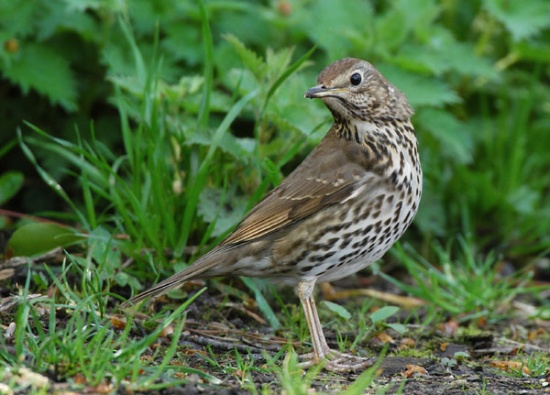(Flight photo added. Attempt to disguise some copied text. Taxonomy. References) |
(Flight photo replaced with underwing shot) |
||
| Line 8: | Line 8: | ||
Sexes are similar | Sexes are similar | ||
====Similar Species==== | ====Similar Species==== | ||
| − | [[Image: | + | [[Image:A forman 389.jpg|thumb|350px|right|Photo by {{user|spock|spock}}<br />[[Norfolk]], February 2010]] |
[[Mistle Thrush]] has greyer upperparts and the spots are round. Female [[Eurasian Blackbird]]s is larger and much darker brown. | [[Mistle Thrush]] has greyer upperparts and the spots are round. Female [[Eurasian Blackbird]]s is larger and much darker brown. | ||
==Distribution== | ==Distribution== | ||
Revision as of 19:18, 6 April 2010

- Turdus philomelos
Identification
22–23 cm
- Plain brown back
- Spotted underparts (arrow-shaped)
- Buffish breast
Sexes are similar
Similar Species
Mistle Thrush has greyer upperparts and the spots are round. Female Eurasian Blackbirds is larger and much darker brown.
Distribution
Found throughout Europe south of the Arctic circle, except Iberia.
They have been introduced to many parts of the world, including New Zealand {where they are common and widespread) and Australia where a small population survives around Melbourne.
Most of the birds winter further south, although some western populations are resident.
Taxonomy
Subspecies[1]
There are 4 subspecies:
- T. p. hebridensis:
- T. p. clarkei:
- British Isles and western Europe; winters to northern Mediterranean basin
- T. p. philomelos:
- T. p. nataliae:
Habitat
Woods, hedges, gardens, tends to avoid wide open spaces.
Behaviour
They do not form flocks, although several birds may be seen together where there is suitable habitat, especially in the winter. They often appear to be rather tame.
Breeding
The twiggy nest is lined with moss or grass. The clutch consists of 3 to 5 blue eggs with dark spots. They are incubated for 14-15 days, fledging after a further 2 weeks. There may be 3 broods in the season which lasts from March to July.
Diet
The diet consists of snails, insects, worms, fruit and berries. To eat the snails, they find a suitable stone which is used as an "anvil" to smash the shell.
Vocalisation
Song: very loud, consisting of short phrases repeated 2-4 times.
<flashmp3>Turdus philomelos (song).mp3</flashmp3>
Listen in an external program
References
- Clements, JF. 2009. The Clements Checklist of Birds of the World. 6th ed., with updates to December 2009. Ithaca: Cornell Univ. Press. ISBN 978-0801445019.
- Animal Corner
- Bird Watching
- BF Member observations
Recommended Citation
- BirdForum Opus contributors. (2024) Song Thrush. In: BirdForum, the forum for wild birds and birding. Retrieved 16 May 2024 from https://www.birdforum.net/opus/Song_Thrush
External Links




